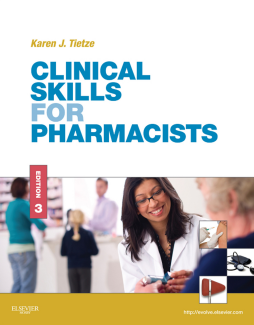
Additional Information
Book Details
Abstract
Covering the skills needed for pharmaceutical care in a patient-centered pharmacy setting, Clinical Skills for Pharmacists: A Patient-Focused Approach, 3rd Edition describes fundamental skills such as communication, physical assessment, and laboratory and diagnostic information, as well as patient case presentation, therapeutic planning, and monitoring of drug intake. Numerous case examples show how skills are applied in clinical situations. Now in full color, this edition adds more illustrations and new coverage on taking a medication history, physical assessment, biomarkers, and drug information. Expert author Karen J. Tietze provides unique, pharmacy-specific coverage that helps you prepare for the NAPLEX and feel confident during patient encounters.
- Coverage of clinical skills prepares you to be more involved with patients and for greater physical assessment and counselling responsibilities, with discussions of communication, taking a medical history, physical assessment, reviewing lab and diagnostic tests, and monitoring drug therapies.
- A logical organization promotes skill building, with the development of each new skill building upon prior skills.
- Learning objectives at the beginning of each chapter highlight important topics.
- Self-assessment questions at the end of each chapter help in measuring your comprehension of learning objectives.
- Professional codes of ethics are described in the Ethics in Pharmacy and Health Care chapter, including confidentiality, HIPAA, research ethics, ethics and the promotion of drugs, and the use of advance directives in end-of-life decisions.
- Numerous tables summarize key and routinely needed information.
- Downloadable, customizable forms on the companion Evolve website make it easier to perform tasks such as monitoring drug intake and for power of attorney.
Table of Contents
| Section Title | Page | Action | Price |
|---|---|---|---|
| Front Cover | Cover | ||
| Clinical Skills For Pharmacists: A Patient-Focused Approach | iii | ||
| Copyright | iv | ||
| Dediction | v | ||
| Preface | vii | ||
| Acknowledgments | viii | ||
| Contents | ix | ||
| Chapter 1 - Introduction: The Practice of Clinical Pharmacy | 1 | ||
| Patient-Focused Pharmacy Practice | 1 | ||
| The Clinical Environment | 5 | ||
| The Health Care Delivery System | 11 | ||
| References | 13 | ||
| Chapter 2 - Communication Skills for the Pharmacist | 14 | ||
| Verbal Communication Skills | 14 | ||
| Written Communication Skills | 17 | ||
| Integration | 18 | ||
| Telecommunication | 24 | ||
| Additional Communication Skills | 24 | ||
| REFERENCES | 28 | ||
| Chapter 3 - Taking Medication Histories | 29 | ||
| Preparation For The Interview | 31 | ||
| Observation Of The Patient And The Patient’s Environment | 31 | ||
| Data To Be Obtained | 33 | ||
| The Difficult Interview | 38 | ||
| Documentation Of The Medication History | 38 | ||
| REFERENCES | 42 | ||
| Chapter 4 - Physical Assessment Skills | 43 | ||
| THE PROCESS | 43 | ||
| INSPECTION, PALPATION, PERCUSSION, AND AUSCULTATION TECHNIQUES | 43 | ||
| EQUIPMENT | 46 | ||
| VITAL SIGNS | 50 | ||
| SKIN | 55 | ||
| HEAD AND NECK | 57 | ||
| CHEST AND LUNGS | 64 | ||
| CARDIOVASCULAR SYSTEM | 70 | ||
| BREASTS AND AXILLAE | 73 | ||
| ABDOMEN | 73 | ||
| GENITOURINARY SYSTEM | 76 | ||
| MUSCULOSKELETAL SYSTEM | 77 | ||
| NEUROLOGIC SYSTEM | 78 | ||
| REFERENCES | 85 | ||
| Chapter 5 - Review of Laboratory and Diagnostic Tests | 86 | ||
| BACKGROUND | 86 | ||
| GENERAL ORGAN SYSTEMS | 86 | ||
| CARDIOVASCULAR SYSTEM | 90 | ||
| ENDOCRINE SYSTEM | 95 | ||
| GASTROINTESTINAL SYSTEM | 97 | ||
| HEMATOLOGIC SYSTEM | 100 | ||
| IMMUNOLOGIC SYSTEM | 105 | ||
| INFECTIOUS DISEASE | 107 | ||
| NEUROLOGIC SYSTEM | 109 | ||
| NUTRITION | 110 | ||
| RENAL SYSTEM | 112 | ||
| RESPIRATORY SYSTEM | 115 | ||
| BIOMARKERS | 117 | ||
| REFERENCES | 122 | ||
| Chapter 6 - The Patient Case Presentation | 123 | ||
| Components | 124 | ||
| REFERENCES | 131 | ||
| Chapter 7 - Therapeutics Planning | 132 | ||
| 1. Identify the Problems | 132 | ||
| 2. Prioritize The Problems | 135 | ||
| 3. Select Patient-Specific Drug And Nondrug Interventions | 136 | ||
| 4. Develop A Monitoring Plan | 138 | ||
| Soap Format | 138 | ||
| References | 144 | ||
| Chapter 8 - Monitoring Drug Therapies | 145 | ||
| Process | 145 | ||
| Application and Integration | 149 | ||
| Chapter 9 - Researching and Providing Drug Information | 154 | ||
| Process | 154 | ||
| Drug Information Centers | 162 | ||
| Sample Drug Information Questions | 163 | ||
| References | 165 | ||
| Chapter 10 - Ethics in Pharmacy and Health Care | 167 | ||
| Professional Codes Of Ethics | 167 | ||
| Ethical Issues | 173 | ||
| References | 182 | ||
| Appendix: Acronyms by Chapter | 184 | ||
| CHAPTER 1 | 184 | ||
| CHAPTER 2 | 185 | ||
| CHAPTER 3 | 185 | ||
| CHAPTER 4 | 185 | ||
| CHAPTER 5 | 186 | ||
| CHAPTER 6 | 188 | ||
| CHAPTER 7 | 190 | ||
| CHAPTER 8 | 191 | ||
| CHAPTER 9 | 192 | ||
| CHAPTER 10 | 192 | ||
| Index | 193 |
